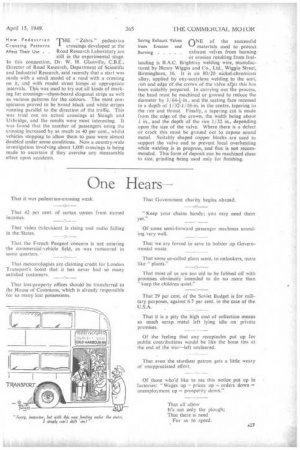Passing Comments
Page 2

Page 3

If you've noticed an error in this article please click here to report it so we can fix it.
Shall We Have SpeedA CLOSE study of the trapping From the " movement of traffic in Air 7 London has been helped by aerial photographs taken by the R.A.F. at a height of some 4,000 ft. These show clearly the positions of all vehicles and, in many cases, pedestrians and even the studs on crossings. By taking successive photographs at timed intervals, with sufficient overlapping, it is possible to record changes in the positions of vehicles and from these to estimate their speeds. This opens up the possibility of employing aerial police instead of the familiar officers with stop-watches or in cars. We trust, however, that the deciphering of .number plates would prove too much for the picture readers and thus relieve us from such an inquisition
A26 Time Passes Quickly THOSE people who have on Good Coach I not indulged in the joys of Trips touring by coach are some
times inclined to believe that long journeys made in this way may be tiring and boring. We have not found this to be the case, and most people find such 'a trip more interesting than a railway journey over a corresponding distance., Recently, we travelled to the Seabank Hotel, Porthcawl, as a week-end guest of South Midland Motor Services, Ltd., Oxford, traversing the same route and being afforded the same facilities as will no doubt hundreds of people who will make the whole eightday luxury holiday, which, of course, covers many special amenities. The run each way occupies about • nine hours, but it is surprising how quickly these pass. H ow Pedestrian Crossing Patterns Affect Their Use . . THE " Zebra" pedestrian crossings developed at the Road Research Laboratory are still in the experimental stage. In this connection, Dr. W. H. Glanville, C.B.E., Director of Road Research, Department of Scientific and Industrial Research, Said recently that a start was made with a small model of a road with a crossing on it, and with model street lamps at appropriate intervals. This was used to try out all kinds of marking for crossings—chess-board diagonal strips as well as various patterns for the colours. The most conspicuous proved to be broad black and white stripes running parallel to the direction of the traffic. This was tried out on actual crossings at Slough and Uxbridge, and the results were most interesting. It was found that the number of passengers using the crossing increased by as much as 40 per cent., whilst vehicles stopping to allow them to pass were almost doubled under some conditions. Now, a country-wide investigation involving about 1,000 crossings is being made to ascertain if they exercise any measurable effect upon accidents. Saving Exhaust Valves ('NE of the successful from Erosion and materials used to protect Burning exhaust valves from burning or erosion resulting from fuelleading is B.A.C. Brightray welding wire, manufactured by Henry Wiggin and Co., Ltd., Wiggin Street, Birmingham, 16. It is an 80/20 nickel-chromium alloy, applied by oxy-acetylene welding to the seat, rim and edge of the crown of the valve after this has been suitably prepared. In carrying out the process, the head must be machined or ground to reduce the diameter by 3 /64-14-in., and the seating face recessed to a depth of 1 / 32-1 / 16-in. in the centre, tapering to the rim and throat. Finally, a tapering cut is made from the edge of the crown, the Width being about 1 in., and the depth of the rim 1/32 in., depending upon the size of the valve. Where there is a defect or crack this must be ground out to expose sound metal. Suitably shaped copper blocks are used to support the valve and to prevent local overheating while welding is in progress, and flux is not recommended. This form of deposit can be machined close to size, grinding being used only for finishing.


























